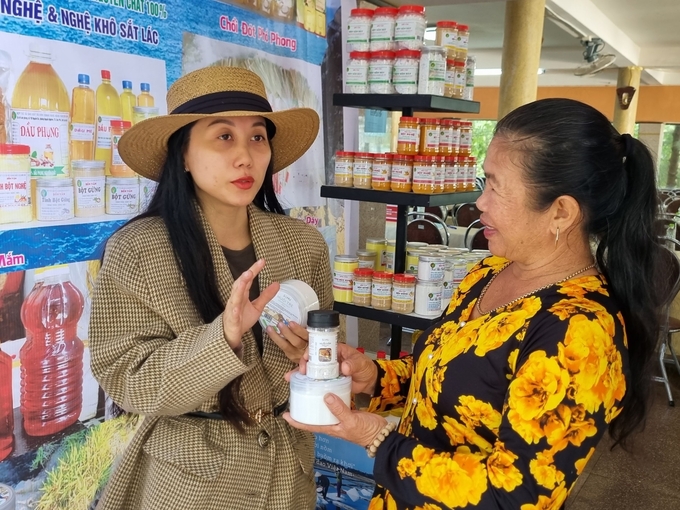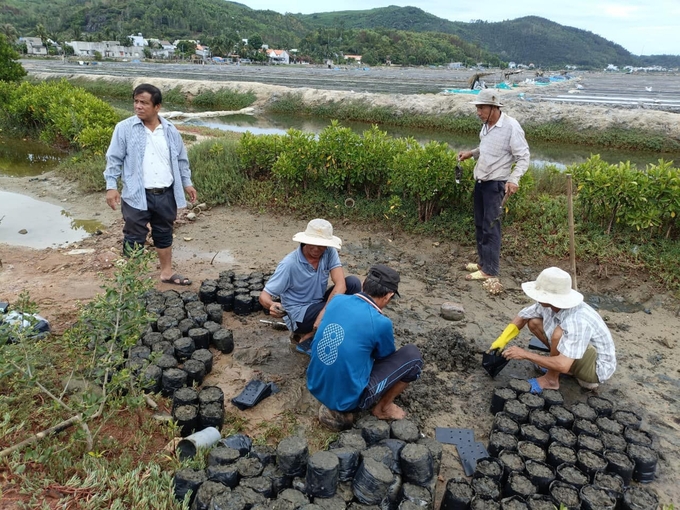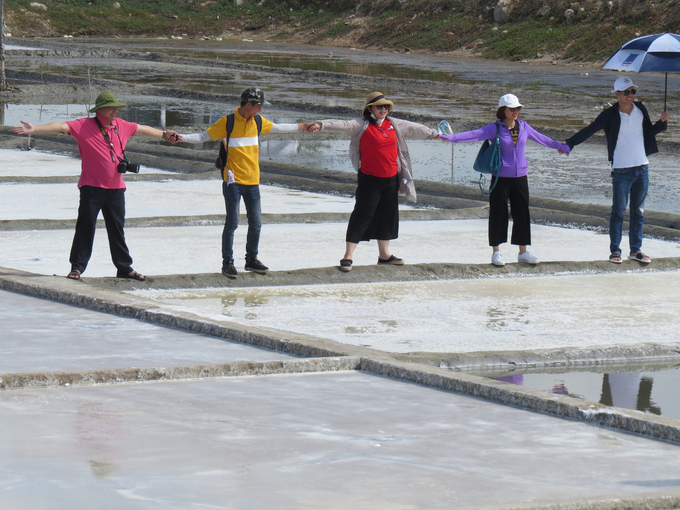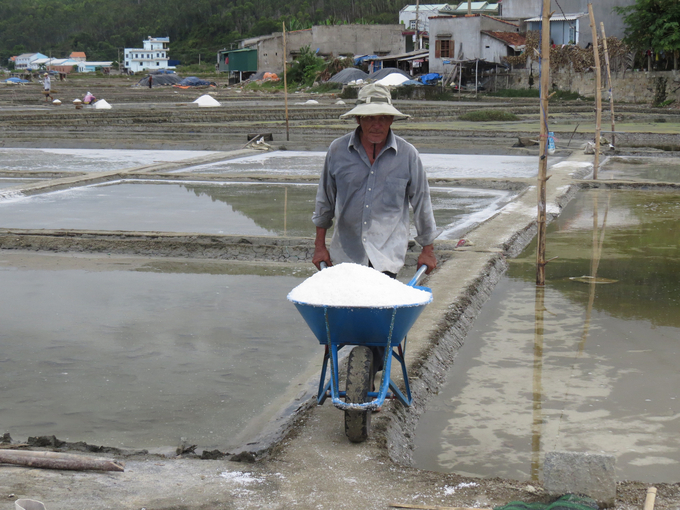November 27, 2025 | 22:28 GMT +7
November 27, 2025 | 22:28 GMT +7
Hotline: 0913.378.918
November 27, 2025 | 22:28 GMT +7
Hotline: 0913.378.918

Pham Hong Tham with products made from Sa Huynh salt. Photo: Vo Thanh Ky.
Nine years ago, the price of salt dropped dramatically. Selling 100 kg of salt was only enough to buy a common bowl of pho. Many young salt workers in Sa Huynh abandoned their salt fields, left their hometowns, and went to other provinces and cities to make a living. There was one young woman who thought otherwise. Pham Hong Tham (born in 1993 in Pho Thanh Ward, Duc Pho Town, Quang Ngai) returned to her hometown to start a salt business after graduating from Ho Chi Minh City University of Economics and Law. She came back because her heart was in her homeland. She felt sorry for the hardships of her beloved salt workers at home.
Tham and her relatives went to meet the salt workers and convinced them to follow the production procedure for high-quality salt. The soil of the salt fields must be compacted more thoroughly to minimize impurities. The time from bringing water into the fields to dry until harvesting is longer than usual so that the salt grains are large and solid. She will then buy salt at a price many times higher than the market price.

Pham Hong Tham introduces salt products. Photo: Vo Thanh Ky.
Tham's facility first produced simple products in the direction of clean food. She gradually gained the capability to secure high-quality products such as flowers of salt, stewed salt (natural salt baked in a clay pot at high temperatures for many days), and bamboo salt with prices ranging from tens to hundreds of thousands of dong per kilogram, dozens of times higher than just selling raw salt.
Six years ago, Tham established SaHu Salt One Member Company Limited (SaHu is short for Sa Huynh) to produce and trade Sa Huynh salt products. The products were sold in many provinces and cities in the country and also exported to foreign countries.

Growing seedlings to plant mangrove forests close to salt fields. Photo: Vo Thanh Ky.
As of date, SaHu’s flowers of salt, stewed salt, and bamboo salt have been recognized as 4-star OCOP products. Every year, Tham helps salt workers sell approximately 200 tons of salt, creating jobs for 10 local workers.
"Tham is a dynamic, bold person. She is passionate about Sa Huynh salt, so after finishing university, she returned to her hometown to start a salt business. When the ward Farmers' Union guided the establishment of the Sa Huynh Salt Flower Community Tourism Cooperative, Tham enthusiastically participated. Now the cooperative has developed into the Sa Huynh Traditional Sea Salt and Community Tourism Cooperative. Tham has been elected to hold the position of Director," said Thai Thuan Lang, Chairman of the Pho Thanh Ward Farmers' Union.
The flowers of salt from SaHu were extremely popular among customers, to the point that there was not enough supply to meet the demand. This product was the quintessence of the sea and sky, along with human ingenuity.
According to salt workers, flowers of salt form on hot sunny days. The wind from the open sea blows to the shore, gently shaking the surface of the water in the salt fields. The sun and wind create a thin layer of crystal floating on the water's surface. This layer of crystal does not touch the ground, so it is extremely clean. Salt workers use a thick net to gently scoop the salt flowers into a dark-colored bamboo basket. The salt flowers then form tiny grains that look very beautiful, and the mild salty taste lingers on the tip of the tongue when tasted.

Overseas Vietnamese youth and students visited salt fields in 2019. Photo: Vo Thanh Ky.
The Sa Huynh salt fields are located near beautiful landscapes that captivate people's hearts. This place is associated with the Sa Huynh culture, which dates back nearly 3,000 years, holding a trove of mysteries. Tourists visiting An Khe lagoon, Go Co community tourism village, and the burial site of the ancient Sa Huynh people often stop by the salt fields to take pictures and record the dreamlike scenery. The community tourism model associated with introducing and promoting salt products was thus born.
Thanks to the support of tourism consultants, the Sa Huynh Salt Flower Community Tourism Cooperative has welcomed many groups of visitors to visit. Now the cooperative has been upgraded to the Sa Huynh Traditional Sea Salt and Community Tourism Cooperative.

Sa Huynh salt workers harvest salt. Photo: Vo Thanh Ky.
Visitors coming here can experience the dreamy beauty of the sea. They will also be able to enjoy delicious dishes made from seafood just caught from the sea and learn more about the Sa Huynh, Champa and Dai Viet cultures that left their mark on this land.
"Many tourists are delighted to hear us perform sac bua (a traditional form of singing of Southern Central people) about the salt industry or seafaring. After watching, they ask for explanations to fully understand the lyrics we just sang. Through that, they thoroughly understand the salt and seafaring industries of the Sa Huynh people,” said salt worker Le Co, a member of the sac bua singing team of Pho Thanh ward.
Salt workers are very excited because Pho Thanh Ward Farmers' Union is currently implementing a project to preserve the traditional Sa Huynh salt fields in conjunction with developing community tourism. The Union proceeds with a total investment of more than VND 1.9 billion. To be more specific, the United Nations Development Program and the Small Grants Programme (Global Environment Facility) fund more than VND 1.1 billion, the rest is from combined and counterpart funds. The project lasts until October 2025 with the goal of raising community awareness in preserving traditional salt fields, promoting Sa Huynh culture and developing community tourism.
Translated by Samuel Pham

(VAN) On November 27, in the meeting with Minister Tran Duc Thang, Mayor Yin Yong shared Beijing’s experience to improve environment and air quality.

(VAN) After 30 years, both sides identified strategic areas of cooperation: sustainable production, increasing coffee value and training for farmers.
/2025/11/27/4910-4-164708_294.jpg)
(VAN) On the afternoon of November 27 in Beijing, Minister of Agriculture and Environment Tran Duc Thang held a working session with several major Chinese enterprises operating in the agriculture and environment sector.

(VAN) The Department of Animal Health issued a provisional guideline requesting local authorities to increase surveillance, collect samples for testing, and conduct epidemiological investigations according to the established procedure.

(VAN) The United Nations recommends that Vietnam utilize data and artificial intelligence to enhance early disaster warnings and reduce GDP losses by 3.2% in the context of climate change.

(VAN) On the morning of November 27 in Beijing, Minister Tran Duc Thang and the Deputy Commissioner General of the General Administration of Customs of China signed a protocol on fresh jackfruit exports.

(VAN) As floodwaters recede, a vast network of irrigation works across eastern Gia Lai is emerging in a state of severe disrepair, with extensive damage demanding urgent restoration ahead of the 2025-2026 winter-spring cropping season.